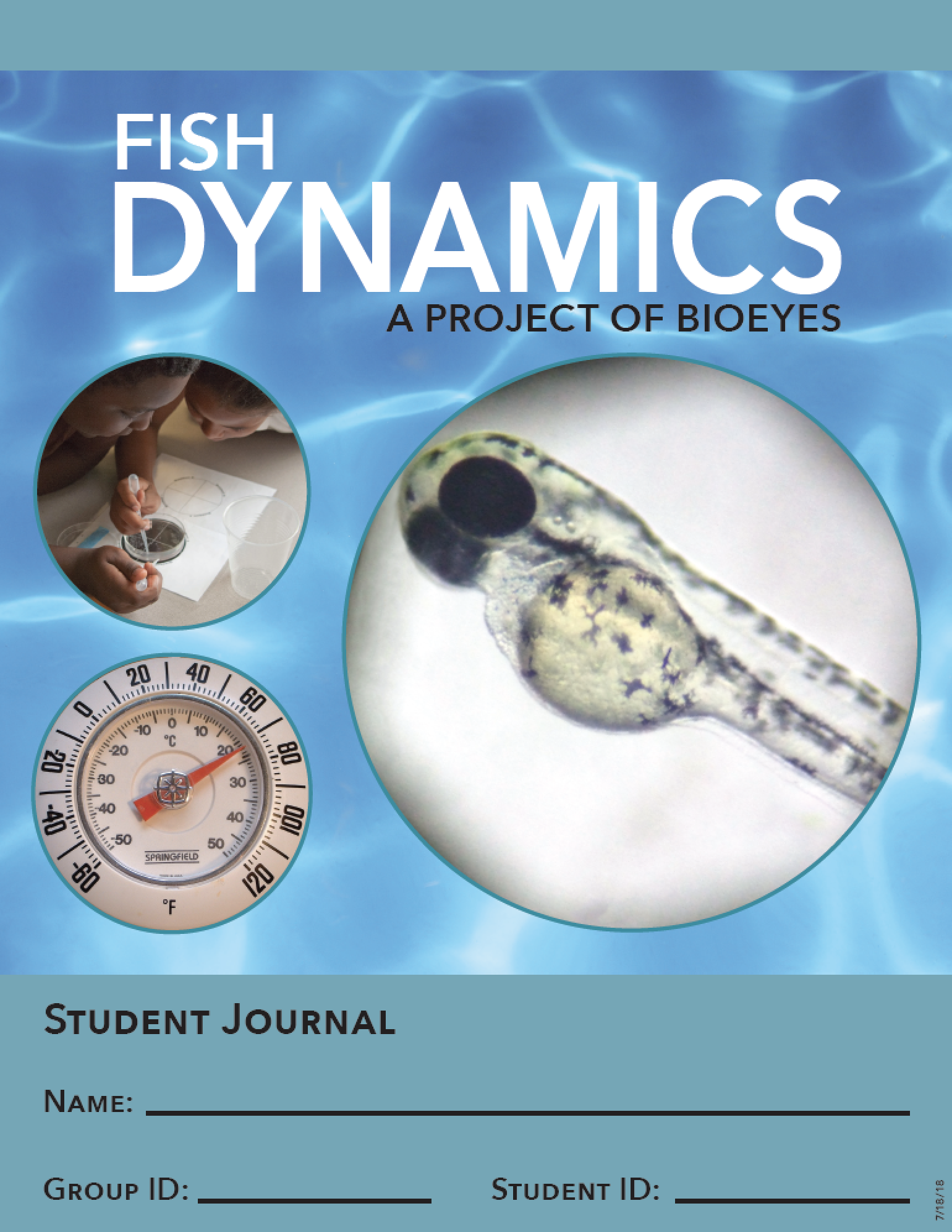Fish Dynamics (Middle school)
MS-LS1 From Molecules to Organisms: Structures and Processes
Students who demonstrate an understanding can:
MS-LS1-1. Conduct an experiment to provide evidence that living things are made of cells; either one cell or many different numbers and types of cells.
MS-LS1-5. Construct a scientific explanation based on evidence for how environmental and genetic factors influence the growth of organisms.
Science and Engineering Practices:
Constructing Explanations and Designing Solutions
Constructing explanations and designing solutions in 6–8 builds on K–5 experiences and progresses to include constructing explanations and designing solutions supported by multiple sources of evidence consistent with scientific knowledge, principles, and theories.
Construct a scientific explanation based on valid and reliable evidence obtained from sources (including the students’ own experiments) and the assumption that theories and laws that describe the natural world operate today as they did in the past and will continue to do so in the future. (MS-LS1-5),(MS-LS1-6)
Planning and Carrying Out Investigations
Planning and carrying out investigations in 6–8 builds on K–5 experiences and progresses to include investigations that use multiple variables and provide evidence to support explanations or solutions.
Conduct an investigation to produce data to serve as the basis for evidence that meet the goals of an investigation. (MS-LS1-1)
Disciplinary Core Ideas:
LS1.A: Structure and Function
All living things are made up of cells, which is the smallest unit that can be said to be alive. An organism may consist of one single cell (unicellular) or many different numbers and types of cells (multicellular). (MS-LS1-1)
LS1.B: Growth and Development of Organisms
Genetic factors as well as local conditions affect the growth of the adult plant. (MS-LS1-5)
Crosscutting Concepts:
Cause and Effect
Phenomena may have more than one cause, and some cause and effect relationships in systems can only be described using probability. (MS-LS1-4),(MS-LS1-5)
Scale, Proportion, and Quantity
Phenomena that can be observed at one scale may not be observable at another scale. (MS-LS-1)
MS-LS2 Ecosystems: Interactions, Energy, and Dynamics
Students who demonstrate an understanding can:
MS-LS2-1. Analyze and interpret data to provide evidence for the effects of resource availability on organisms and populations of organisms in an ecosystem.
MS-LS2-4. Construct an argument supported by empirical evidence that changes to physical or biological components of an ecosystem affect populations.
Science and Engineering Practices:
Analyzing and Interpreting Data
Analyzing data in 6–8 builds on K–5 experiences and progresses to extending quantitative analysis to investigations, distinguishing between correlation and causation, and basic statistical techniques of data and error analysis.
Analyze and interpret data to provide evidence for phenomena. (MS-LS2-1)
Engaging in Argument from Evidence
Engaging in argument from evidence in 6–8 builds on K–5 experiences and progresses to constructing a convincing argument that supports or refutes claims for either explanations or solutions about the natural and designed world(s).
Construct an oral and written argument supported by empirical evidence and scientific reasoning to support or refute an explanation or a model for a phenomenon or a solution to a problem. (MS-LS2-4)
Connections to Nature of Science: Scientific Knowledge is Based on Empirical Evidence
Science disciplines share common rules of obtaining and evaluating empirical evidence. (MS-LS2-4)
Disciplinary Core Ideas:
LS2.A: Interdependent Relationship in Ecosystems
Organisms, and populations of organisms, are dependent on their environmental interactions both with other living things and with nonliving factors. (MS-LS2-1)
Growth of organisms and population increases are limited by access to resources. (MS-LS2-1)
LS2.C: Ecosystem Dynamics, Functioning, and Resilience
Ecosystems are dynamic in nature; their characteristics can vary over time. Disruptions to any physical or biological component of an ecosystem can lead to shifts in all its populations. (MS-LS2-4)
Crosscutting Concepts:
Cause and Effect
Cause and effect relationships may be used to predict phenomena in natural or designed systems. (MS-LS2-1)
Stability and Change
Small changes in one part of a system might cause large changes in another part. (MS-LS2-4),(MS-LS2-5)
MS-ETS1 Engineering Design
Students who demonstrate an understanding can:
MS-ETS1-1. Define the criteria and constraints of a design problem with sufficient precision to ensure a successful solution, taking into account relevant scientific principles and potential impacts on people and the natural environment that may limit possible solutions.
Science and Engineering Practices:
Asking Questions and Defining Problems
Asking questions and defining problems in grades 6–8 builds on grades K–5 experiences and progresses to specifying relationships between variables, and clarifying arguments and models.
Define a design problem that can be solved through the development of an object, tool, process or system and includes multiple criteria and constraints, including scientific knowledge that may limit possible solutions. (MS-ETS1-1)
Disciplinary Core Ideas:
ETS1.A: Defining and Delimiting Engineering Problems
The more precisely a design task’s criteria and constraints can be defined, the more likely it is that the designed solution will be successful. Specification of constraints includes consideration of scientific principles and other relevant knowledge that are likely to limit possible solutions. (MS-ETS1-1)

